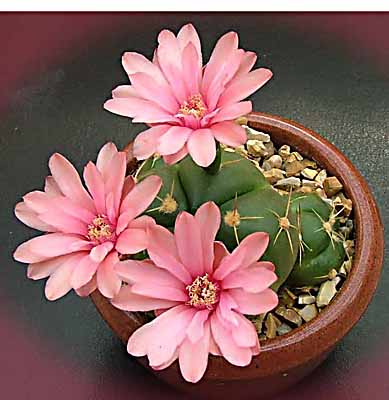
Growth Habits: The body of the plant is virtually round, and usually but not always dullish green. It consists of 5 almost flattened ribs and offsetting is from the base. It may attain a diameter of 4in. (10cm.) depending upon whether the offsets are removed or not. The areoles are round and quite prominent when young. Radial spines are smooth and white and usually about five in number, recurving into to the body.
Scientific name: Gymnocalycium buenekeri
Common names: ?
Synonym: Gymnocalycium horstii var. buenekeri
Etymology: Gymnocalycium: From the Greek words gymnos, meaning naked and kalyx, meaning bud. Buenekeri: Named after H. Buenecker.
Origin: Brazil (Rio Grande do Sul)
Light: This plant does not like too much sun and will do much better in partial shade where it will show itself off to best advantage.
Compost: Use your normal compost mix for this plant.
Water: Can be watered freely during the summer months, but do not allow it to become water-logged. Keep dry in winter.
Flower: The flower is typical of a Gymnocalycium (some of the most beautiful in the cacti world) and can last for two or three days. They will normally only open in sunshine. The colour is difficult to describe (perhaps the above photograph will do it better than I can). Suffice to say that the outer petals have a faint brownish tinge to them while the inner ones are different shades of rose pink deepening to a claret coloured throat. The stamens are yellow and the style and stigma are white.
Fruit: Blue-green.
Min. temp: 50f. (10c.)
Cultivation: This plant like most Gymnocalycium is relatively easy to keep and is not too demanding of the grower. A dilute dose of fertiliser once a month is beneficial to the plant. It is a relatively quick grower and throws offsets on a regular basis. These can be detached if desired to form a new plant. The one thing that does annoy me about the plant is that the main body tends to force itself up out of the compost particularly when it is offsetting and this leaves a ‘collar’ of compost showing underneath the plant. The plant requires some shade and young plants in particular respond badly to long periods of drought or too much sunshine.
Habitat: The plants grow in rather damp areas where they receive some shade from other vegetation.
Comments: Room can usually be found for one of these as it is not a particularly large cactus, although if it is allowed to offset freely it can make quite a large clump. As with most other cacti the size of the body is governed by whether you leave the offsets on the main plant or remove them for cuttings. Once it has reached maturity it will usually reward the grower with a good show of flowers each year. Buenekeri or its close partner horstii (there is very little difference between the two apart from flower colour. Horstii is creamy white), are usually not too difficult to find and are well worth a place in a collection of mixed cacti.










